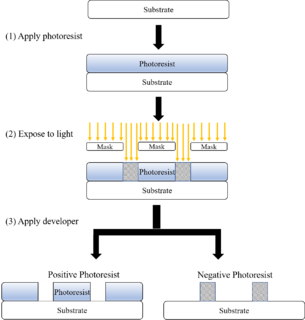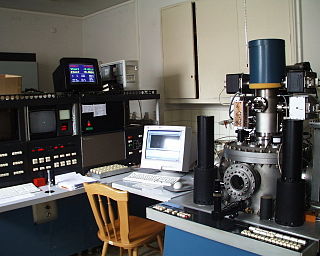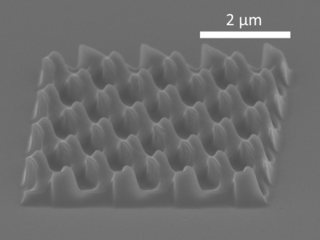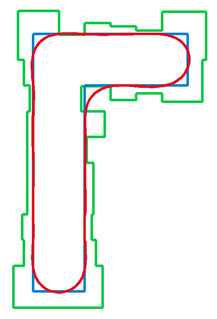Related Research Articles
In integrated circuit manufacturing, photolithography or optical lithography is a general term used for techniques that use light to produce minutely patterned thin films of suitable materials over a substrate, such as a silicon wafer, to protect selected areas of it during subsequent etching, deposition, or implantation operations. Typically, ultraviolet light is used to transfer a geometric design from an optical mask to a light-sensitive chemical (photoresist) coated on the substrate. The photoresist either breaks down or hardens where it is exposed to light. The patterned film is then created by removing the softer parts of the coating with appropriate solvents.

A photoresist is a light-sensitive material used in several processes, such as photolithography and photoengraving, to form a patterned coating on a surface. This process is crucial in the electronic industry.
A photomask is an opaque plate with holes or transparencies that allow light to shine through in a defined pattern. They are commonly used in photolithography and the production of integrated circuits in particular. Masks are used to produce a pattern on a substrate, normally a thin slice of silicon known as a wafer in the case of chip manufacturing. Several masks are used in turn, each one reproducing a layer of the completed design, and together they are known as a mask set.

Immersion lithography is a photolithography resolution enhancement technique for manufacturing integrated circuits (ICs) that replaces the usual air gap between the final lens and the wafer surface with a liquid medium that has a refractive index greater than one. The resolution is increased by a factor equal to the refractive index of the liquid. Current immersion lithography tools use highly purified water for this liquid, achieving feature sizes below 45 nanometers. ASML and Nikon are currently the only manufacturers of immersion lithography systems.

Electron-beam lithography is the practice of scanning a focused beam of electrons to draw custom shapes on a surface covered with an electron-sensitive film called a resist (exposing). The electron beam changes the solubility of the resist, enabling selective removal of either the exposed or non-exposed regions of the resist by immersing it in a solvent (developing). The purpose, as with photolithography, is to create very small structures in the resist that can subsequently be transferred to the substrate material, often by etching.
Masklesslithography (MPL) is a photomask-less photolithography-like technology used to project or focal-spot write the image pattern onto a chemical resist-coated substrate by means of UV radiation or electron beam.
Nanolithography (NL) is a growing field of techniques within nanotechnology dealing with the engineering of nanometer-scale structures on various materials.

Extreme ultraviolet lithography is an optical lithography technology used in steppers, machines that make integrated circuits (ICs) for computers and other electronic devices. It uses a range of extreme ultraviolet (EUV) wavelengths, roughly spanning a 2% FWHM bandwidth about 13.5 nm, to produce a pattern by exposing reflective photomask to UV light which gets reflected onto a substrate covered by photoresist. It is widely applied in semiconductor device fabrication process.
Next-generation lithography or NGL is a term used in integrated circuit manufacturing to describe the lithography technologies in development which are intended to replace current techniques. The term applies to any lithography method which uses a shorter-wavelength light or beam type than the current state of the art, such as X-ray lithography, electron beam lithography, focused ion beam lithography, and nanoimprint lithography. The term may also be used to describe techniques which achieve finer resolution features from an existing light wavelength.

A stepper is a device used in the manufacture of integrated circuits (ICs) that is similar in operation to a slide projector or a photographic enlarger. Stepper is short for step-and-repeat camera. Steppers are an essential part of the complex process, called photolithography, which creates millions of microscopic circuit elements on the surface of chips of silicon. These chips form the heart of ICs such as computer processors, memory chips, and many other devices.

Nanoimprint lithography (NIL) is a method of fabricating nanometer scale patterns. It is a simple nanolithography process with low cost, high throughput and high resolution. It creates patterns by mechanical deformation of imprint resist and subsequent processes. The imprint resist is typically a monomer or polymer formulation that is cured by heat or UV light during the imprinting. Adhesion between the resist and the template is controlled to allow proper release.
A superlens, or super lens, is a lens which uses metamaterials to go beyond the diffraction limit. For example, in 1995, Guerra combined a transparent grating having 50nm lines and spaces with a conventional microscope immersion objective. The resulting "superlens" resolved a silicon sample also having 50nm lines and spaces, far beyond the classical diffraction limit imposed by the illumination having 650nm wavelength in air. The diffraction limit is a feature of conventional lenses and microscopes that limits the fineness of their resolution depending on the illumination wavelength and the numerical aperture NA of the objective lens. Many lens designs have been proposed that go beyond the diffraction limit in some way, but constraints and obstacles face each of them.

Optical proximity correction (OPC) is a photolithography enhancement technique commonly used to compensate for image errors due to diffraction or process effects. The need for OPC is seen mainly in the making of semiconductor devices and is due to the limitations of light to maintain the edge placement integrity of the original design, after processing, into the etched image on the silicon wafer. These projected images appear with irregularities such as line widths that are narrower or wider than designed, these are amenable to compensation by changing the pattern on the photomask used for imaging. Other distortions such as rounded corners are driven by the resolution of the optical imaging tool and are harder to compensate for. Such distortions, if not corrected for, may significantly alter the electrical properties of what was being fabricated. Optical proximity correction corrects these errors by moving edges or adding extra polygons to the pattern written on the photomask. This may be driven by pre-computed look-up tables based on width and spacing between features or by using compact models to dynamically simulate the final pattern and thereby drive the movement of edges, typically broken into sections, to find the best solution,. The objective is to reproduce on the semiconductor wafer, as well as possible, the original layout drawn by the designer.
Resolution enhancement technologies are methods used to modify the photomasks in the lithographic processes used to make integrated circuits to compensate for limitations in the optical resolution of the projection systems. These processes allow the creation of features well beyond the limit that would normally apply due to the Rayleigh criterion. Modern technologies allow the creation of features on the order of 5 nanometers (nm), far below the normal resolution possible using deep ultraviolet (DUV) light.
Interference lithography is a technique for patterning regular arrays of fine features, without the use of complex optical systems or photomasks.
Nanophotonics or nano-optics is the study of the behavior of light on the nanometer scale, and of the interaction of nanometer-scale objects with light. It is a branch of optics, optical engineering, electrical engineering, and nanotechnology. It often involves dielectric structures such as nanoantennas, or metallic components, which can transport and focus light via surface plasmon polaritons.
Plasmonic nanolithography is a nanolithographic process that utilizes surface plasmon excitations such as surface plasmon polaritons (SPPs) to fabricate nanoscale structures. SPPs, which are surface waves that propagate in between planar dielectric-metal layers in the optical regime, can bypass the diffraction limit on the optical resolution that acts as a bottleneck for conventional photolithography.
Computational lithography is the set of mathematical and algorithmic approaches designed to improve the resolution attainable through photolithography. Computational lithography has come to the forefront of photolithography in 2008 as the semiconductor industry grappled with the challenges associated with the transition to 22 nanometer CMOS fabrication process technology and beyond.

X-ray lithography is a process used in semiconductor device fabrication industry to selectively remove parts of a thin film of photoresist. It uses X-rays to transfer a geometric pattern from a mask to a light-sensitive chemical photoresist, or simply "resist," on the substrate to reach extremely small topological size of a feature. A series of chemical treatments then engraves the produced pattern into the material underneath the photoresist.
Surface plasmon resonance microscopy (SPRM), also called surface plasmon resonance imaging (SPRI), is a label free analytical tool that combines the surface plasmon resonance of metallic surfaces with imaging of the metallic surface. The heterogeneity of the refractive index of the metallic surface imparts high contrast images, caused by the shift in the resonance angle. SPRM can achieve a sub-nanometer thickness sensitivity and lateral resolution achieves values of micrometer scale. SPRM is used to characterize surfaces such as self-assembled monolayers, multilayer films, metal nanoparticles, oligonucleotide arrays, and binding and reduction reactions. Surface plasmon polaritons are surface electromagnetic waves coupled to oscillating free electrons of a metallic surface that propagate along a metal/dielectric interface. Since polaritons are highly sensitive to small changes in the refractive index of the metallic material, it can be used as a biosensing tool that does not require labeling. SPRM measurements can be made in real-time, such as measuring binding kinetics of membrane proteins in single cells, or dna hybridization.
References
- ↑ Su, Frederic (1997-02-01). "Microlithography: from contact printing to projection systems". SPIE Newsroom. SPIE-Intl Soc Optical Eng. doi:10.1117/2.6199702.0001. ISSN 1818-2259.
- 1 2 3 4 5 Luo, Xiangang; Ishihara, Teruya (2004-06-07). "Surface plasmon resonant interference nanolithography technique". Applied Physics Letters. AIP Publishing. 84 (23): 4780–4782. Bibcode:2004ApPhL..84.4780L. doi:10.1063/1.1760221. ISSN 0003-6951.
- 1 2 3 Melville, David O. S.; Blaikie, Richard J. (2005). "Super-resolution imaging through a planar silver layer". Optics Express. The Optical Society. 13 (6): 2127–2134. Bibcode:2005OExpr..13.2127M. doi: 10.1364/opex.13.002127 . ISSN 1094-4087. PMID 19495100.
- ↑ Gao, Ping; Yao, Na; Wang, Changtao; Zhao, Zeyu; Luo, Yunfei; et al. (2015-03-02). "Enhancing aspect profile of half-pitch 32 nm and 22 nm lithography with plasmonic cavity lens". Applied Physics Letters. AIP Publishing. 106 (9): 093110. Bibcode:2015ApPhL.106i3110G. doi:10.1063/1.4914000. ISSN 0003-6951.
- ↑ "Contact Lithography". www.nanotech.ucsb.edu. Archived from the original on 2010-06-26.
- ↑ Martin, Olivier J. F.; Piller, Nicolas B.; Schmid, Heinz; Biebuyck, Hans; Michel, Bruno (1998-09-28). "Energy flow in light-coupling masks for lensless optical lithography". Optics Express. The Optical Society. 3 (7): 280–285. Bibcode:1998OExpr...3..280M. doi: 10.1364/oe.3.000280 . ISSN 1094-4087. PMID 19384370.
- ↑ Cheng, Xing; Jay Guo, L. (2004). "A combined-nanoimprint-and-photolithography patterning technique". Microelectronic Engineering. Elsevier BV. 71 (3–4): 277–282. doi:10.1016/j.mee.2004.01.041. ISSN 0167-9317.
- ↑ McNab, Sharee J.; Blaikie, Richard J. (2000-01-01). "Contrast in the evanescent near field of λ/20 period gratings for photolithography". Applied Optics. The Optical Society. 39 (1): 20–25. Bibcode:2000ApOpt..39...20M. doi:10.1364/ao.39.000020. ISSN 0003-6935. PMID 18337865.
- ↑ Luo, Xiangang; Ishihara, Teruya (2004). "Subwavelength photolithography based on surface-plasmon polariton resonance". Optics Express. The Optical Society. 12 (14): 3055–3065. Bibcode:2004OExpr..12.3055L. doi: 10.1364/opex.12.003055 . ISSN 1094-4087. PMID 19483824.
- ↑ Porto, J. A.; García-Vidal, F. J.; Pendry, J. B. (1999-10-04). "Transmission Resonances on Metallic Gratings with Very Narrow Slits". Physical Review Letters. American Physical Society (APS). 83 (14): 2845–2848. arXiv: cond-mat/9904365 . Bibcode:1999PhRvL..83.2845P. doi:10.1103/physrevlett.83.2845. ISSN 0031-9007. S2CID 27576694.
- 1 2 X. Jiao et al., Progress in Electromagnetics Research Symposium 2005, pp. 1-5 (2005)
- ↑ Smith, David R.; Schurig, David; Rosenbluth, Marshall; Schultz, Sheldon; Ramakrishna, S. Anantha; Pendry, John B. (2003-03-10). "Limitations on subdiffraction imaging with a negative refractive index slab". Applied Physics Letters. 82 (10): 1506–1508. arXiv: cond-mat/0206568 . Bibcode:2003ApPhL..82.1506S. doi:10.1063/1.1554779. ISSN 0003-6951. S2CID 39687616.
- ↑ Salomon, Laurent; Grillot, Frédéric; Zayats, Anatoly V.; de Fornel, Frédérique (2001-02-05). "Near-Field Distribution of Optical Transmission of Periodic Subwavelength Holes in a Metal Film". Physical Review Letters. American Physical Society (APS). 86 (6): 1110–1113. Bibcode:2001PhRvL..86.1110S. doi:10.1103/physrevlett.86.1110. ISSN 0031-9007. PMID 11178022.
- ↑ Srituravanich, Werayut; Fang, Nicholas; Sun, Cheng; Luo, Qi; Zhang, Xiang (2004). "Plasmonic Nanolithography". Nano Letters. American Chemical Society (ACS). 4 (6): 1085–1088. Bibcode:2004NanoL...4.1085S. doi:10.1021/nl049573q. ISSN 1530-6984.
- ↑ E.g., W. Cai et al., Appl. Phys. Lett. vol. 83, pp. 1705-1710 (1998)